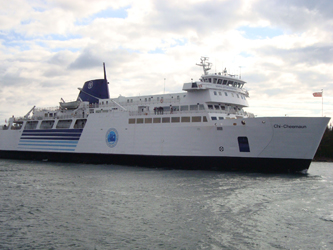OWEN SOUND—The Owen Sound Transportation Company (OSTC) released its highly anticipated market feasibility study for the MS Chi-Cheemaun this past Tuesday (March 12), along with planned changes to ferry operations for the 2013 season and beyond during a media event held aboard the ferry at its Owen Sound berth.
The marketing study, conducted by the management consulting and strategy advisory firm CPCS Transcom that specializes in the transportation sector, provided recommendations to the OSTC on how to increase ferry ridership and improve the passenger sailing experience.
The issue of declining ridership has been building over the past few years, falling from 232,000 passengers in 2005 to about 170,000 passengers in 2011. That trend is clearly unsustainable noted OSTC CEO Susan Schrempf, and she emphasized that the company needs to look beyond its existing customer base if it wishes to survive.
“If we focus only on our existing market, we will be out of business in five years,” she said in response to a question from the audience about potential in the commercial trucking sector. “We can’t just focus on one sector of the market.” That being said, the ferry garners some 60 percent of its current revenues from the tourism sector and most of the potential for expanding that sector appears to lie among younger families in the GTA and Golden Horseshoe seeking relatively close and cost effective vacation experiences.
The marketing study sought to “identify those markets not currently using the ferry service, and outline procedures and operational changes required to attract these potential passengers to the ferry while retaining its current customer base.”
The consultants not only conducted an in-depth analysis of market factors to prepare the report, but also held public information sessions during the fall of 2012 in South Baymouth and Tobermory on the Bruce Peninsula, the north and south terminals for the ferry’s operations. The public sessions gave “our communities on the Bruce Peninsula and Manitoulin Island an opportunity to voice their concerns and provide feedback to the consultant,” said Ms. Schrempf. “The public input was very insightful and assisted CPCS with identifying issues that required immediate attention.”
As a result of the findings in the marketing study, passengers of the Chi-Cheemaun can expect to see some key operational changes in the 2013 sailing season, according to Ms. Schrempf. Among those changes will be the elimination of the reservation fee. A reservation can now be made on any sailing at no additional cost.
The reservation fee was clearly identified as an irritant to existing users of the system at both of the public informations sessions, and that negative impact was borne out by the consultants’ other studies.
In addition to removing the reservation fee, the ferry will move to an on-peak/off-peak fare structure, announced Ms. Schrempf. “On-peak fares will be charged for all summer sailings and off-peak fares will be charged for all spring and fall sailings,” she said. The shoulder season will see fares remain the same as last year, while the peak summer months will see an increase. The result will be that an average user, a single passenger in a commuter vehicle who would normally utilize the reservation system, will see about a net five dollar reduction in the cost of using the ferry for a one-way trip.
The ferry will also introduce a customer loyalty program to reward frequent users, but the details of how that will work are still being formalized. It will not be a traditional discount program, but is more likely to focus on moving traffic from busy crossings to those crossings with lighter loads. In any event, any kind of loyalty program must first be approved by the board of the OSTC and then signed off by the company’s shareholder, the Province of Ontario.
Key to the success of the marketing efforts will be “enhanced marketing efforts focussed on the leisure traveller.” It is this group who currently provides the bulk of the ferry traffic, and it is attracting a greater share of this market by targeted marketing in which its greatest hope for viability lie. The study clearly shows that relying solely on its role as a transportation link would be a recipe for financial disaster.
Although the financial position of the ferry operation combined with the current challenge provided by the provincial fiscal challenges do not provide a comforting environment for securing the marketing funds for expanding the ferry’s profile in target market sectors, Ms. Schrempf said that the province has indicated that they would be supportive of the initiative.
Future projects resulting from the study will include improving the company website to make online reservations quicker and easier. The website was identified as an irritant to potential customers during the public session. With more and more travellers planning their vacations through online research, the first point of contact with the market is centering more and more upon the Internet.
Other projects being planned for the future include improving on-board amenities, such as cafeteria upgrades and providing more activities or entertainment while sailing, as well as improving the visibility of the ferry option through providing better highway signage.
The report highlights the importance of creating vibrant experiential products that include the ferry and the need for inclusion of tourism stakeholders such as the Manitoulin Tourism Association (MTA) in marketing those products and tourism sector partnerships in the creation and packaging of those products.
“This is not something that we at OSTC can do for ourselves or something that we have the budget for,” she said. “As you know we are owned by the province, we are funded by the province, and the province is having its own financial difficulties right now, but the province has told us they will support us in this effort.”
The OSTC will be going outside of itself to engage the proper marketing firm to put together “an appropriate marketing package to focus advertising, promotions and customer relations efforts in those areas where we need focus,” said Ms. Schrempf.
The focus of marketing programs will be on regions like the GTA (Greater Toronto Area), as it is in these areas that the ferry as an experience and vacation option is relatively unknown and where the potential market for expansion is huge. “That is where the most benefit is going to come from,” noted Ms. Schrempf.
Ms. Schrempf noted that consultation with the trucking industry indicated that the main player (later identified as Manitoulin Transport) in the region utilizes Sudbury as a hub. The problem is not simply one of cost but is far more complex, noted Ms. Schrempf. “It is also a question of logistics,” she said, adding that the ridership issue contains a complex mix of factors. “We are not going to solve this issue one truck at a time.”
The OSTC focus over the next three years will be on tourists, but the OSTC is keenly aware that they must also keep their existing customers happy. “Commercial truckers are not outside of the conversation,” noted Ms. Schrempf, but at less than seven percent of the traffic volume, and given the limitations of space during the peak operations, the future of the ferry lies in the expanding its reach in the leisure market.
“I think it is great that the OSTC is pursuing improving the service and making it more viable,” said MTA president Ken Ferguson. “We are looking forward to the next stages and we will be glad to work with them.”
The full report can be viewed at www.chicheemaunmarketstudy.com




